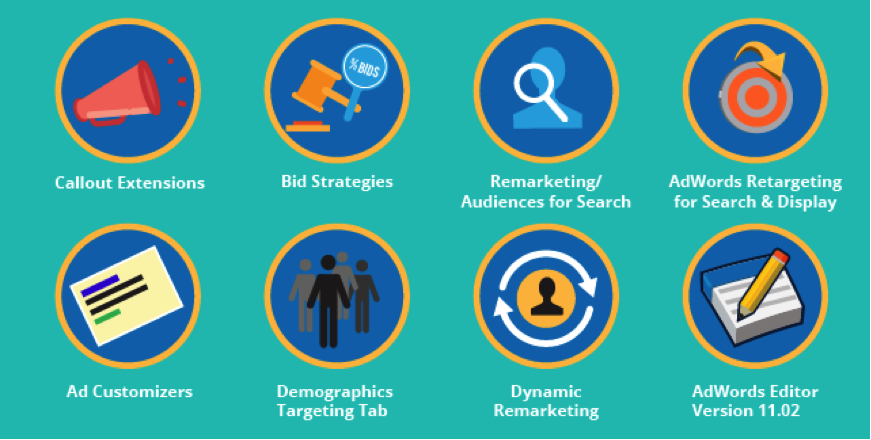AdWords are beneficial because they can help your business attract more customers (these ads are listed first on the search results page), you can target your audience to meet your businesses’ needs (are you trying to reach people locally, nationally, or globally?) and you only have to pay when someone clicks on your ad (essentially, when the advertising is actually working). Using AdWords is one of the most cost-effective ways to market your Ecommerce business. Seems like a no-brainer, right?
That being said, navigating the world of AdWords can be a bit complicated, especially for a beginner. There are more ways to improve your Ecommerce campaigns using AdWords than what’s written on Google’s AdWords home page. Read below to find out how to maximize your AdWords potential in order to increase your website traffic, and your product sales, using this pay-per-click advertising option.
Use Google Sitelinks
Sitelinks appear below your Google Ad and direct people to other parts of your website. They help consumers better locate the information they are looking for, such as store hours and location. See the example below from Google:
Most of the time they are free and easy to set up, and they allow you to increase the amount of space your ad takes up on the search results page. They also positively impact your Click-Through-Rates (CTR). Did I mention they are free and easy? What have you got to lose? The Google Ad Sitelinks support page is a helpful resource to use if you want more information on the benefits of this feature and how to get started.
Take Advantage of the New Features
Another infographic from White Shark Media nicely details all the new features Google AdWords have to offer, that you should be taking advantage of. Many Ecommerce companies forget tend to stay away from getting creative or changing their strategy with new features, but it’s a great way to help your business stand out and keep moving forward.
It’s no longer just about paid advertisements, and if you’re not looking into all these new options you’re missing out on serious potential for your business. This article by WordStream offers more details about some of the above features.
Shopping Campaigns
Google Shopping Campaigns allow you to bid on product-based searches, as opposed to keywords. Another big difference is that shopping campaigns let you include photos, prices, and other promotional information in the advertisements. Shopping campaigns are geared towards promoting your products specifically, as opposed to promoting your business and website.
Another great thing about shopping campaigns is that they appear first on a search-results page, even before the text advertisements. Click here to read about the amazing results businesses have received by using shopping campaigns.
Use Tracking
Google offers AdWords Conversion tracking, as well as Google Analytics, for free. According to Search Engine Journal, “a status report on new accounts at White Shark Media resulted in 71% of all new e-commerce clients not having linked their AdWords to Analytics.” The moral of the story: You don’t want to spend a ton of money on advertising for your business to NOT keep track of whether or not it is working. Because tracking allows you to see how often an ad click turns into an action on your website, you can keep track of your ROI, or Return on Investment. By tracking your advertising, you can see what works and what doesn’t, and then hopefully adapt your keywords and other features to maximize your ROI.
Focus on Keywords
More specifically, negative keywords. These are a must. They allow you to specify keywords where you don’t want your ads to turn up. You don’t want users clicking on your ads looking for something that they won’t find on your site, such as free products or free trials of a product, and therefore incurring unnecessary costs to you and your business. This will also positively impact your business’s ROI, so be sure that when you’re setting up an AdWords campaign you include negative keywords and don’t just focus on your “main” keywords that you’re bidding on. You can learn more about keyword research from our PPC marketing agency here.
Create a Mobile-Friendly Website
Mobile isn’t going anywhere, and if anything, the amount of searches being completed on mobile devices are only increasing. Take advantage of this market, and write specific ads for mobile devices. That way, when you optimize your ads it will be easy to see if a mobile ad specifically is doing better or worse than others, and will hopefully motivate you to make improvements in this area. Creating mobile-specific ads makes this step a lot quicker and easier to complete. Search Engine Journal also suggests adding mobile ads to the top 10% of your Ad Groups so that you don’t get overwhelmed by the mass amount of mobile ads you need to create.
This article in itself is a lot of information to process, especially for the AdWords beginner, so I suggest choosing one tip from the list and implementing it today. Then set aside a little time each day to focus on the others—in the end, your Ecommerce ad campaign will thank you for it. How are you going to start? Do you have any tips not listed in this article? Please share in the comments below!




